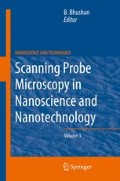Abstract
Nanoscale science and technology demands novel approaches and new knowledge for further development. Nanofabrication has been widely employed in modern science and engineering. Probe-based nanolithography is a common technique to manufacture nanostructures. This research contributes fundamental understanding in surface science through development of a new methodology. A delicate hardware system was designed and constructed to realize the nanometer-scale direct writing. A simple and unique process, namely, laser-assisted scanning probe alloying nanolithography (LASPAN), to fabricate well-defined nanostructures has been developed. The LASPAN system, process, and the application in gold-silicon (Au-Si) binary system have been discussed in this chapter.
Access this chapter
Tax calculation will be finalised at checkout
Purchases are for personal use only
Notes
- 1.
∗ Currently at Applied Optoelectronics, Inc.
- 2.
† Currently at Harvard University
References
R.C. Jaeger, Introduction to Microelectronic Fabrication, 2nd edn. Modular Series on Solid State Devices (Prentice Hall, Upper Saddle River, 2002)
M.J. Madou, Fundamentals of Microfabrication: The Science of Miniaturization, 2nd edn. (CRC Press, Boca Raton, 2002)
N.M. Miskovsky, T.T. Tsong, Field evaporation of gold in single- and double-electrode systems. Phys. Rev. B 46(4), 2640 (1992)
J.I. Pascual, et al., Quantum contact in gold nanostructures by scanning tunneling microscopy. Phys. Rev. Lett. 71(12), 1852 (1993)
G.S. Hsiao, R.M. Penner, J. Kingsley, Deposition of metal nanostructures onto Si(111) surfaces by field evaporation in the scanning tunneling microscope. Appl. Phys. Lett. 64(11), 1350–1352 (1994)
D.H. Huang, T. Nakayama, M. Aono, Platinum nanodot formation by atomic point contact with a scanning tunneling microscope platinum tip. Appl. Phys. Lett. 73(23), 3360–3362 (1998)
D. Sundrani, S.B. Darling, S.J. Sibener, Hierarchical assembly and compliance of aligned nanoscale polymer cylinders in confinement. Langmuir 20(12), 5091–5099 (2004)
A. Laracuente, M.J. Bronikowski, A. Gallagher, Chemical vapor deposition of nanometer-size aluminum features on silicon surfaces using an STM tip. Appl. Surf. Sci. 107, 11–17 (1996)
G. Binnig, C.F. Quate, C. Gerber, Atomic force microscope. Phys. Rev. Lett. 56(9), 930 (1986)
G. Binnig, H. Rohrer, Scanning tunneling microscopy. IBM J. Res. Dev. 44(1–2), 279–293 (2000)
G. Binnig, et al., Surface studies by scanning tunneling microscopy. Phys. Rev. Lett. 49(1), 57 (1982)
R.D. Piner, et al., “Dip-Pen” nanolithography. Science 283(5402), 661–663 (1999)
S.Y. Chou, P.R. Krauss, P.J. Renstrom, Imprint lithography with 25-nanometer resolution. Science 272(5258): 85–87 (1996)
J.A. Dagata, et al., Modification of hydrogen-passivated silicon by a scanning tunneling microscope operating in air. Appl. Phys. Lett. 56(20), 2001–2003 (1990)
H.C. Day, D.R. Allee, Selective area oxidation of silicon with a scanning force microscope. Appl. Phys. Lett. 62(21), 2691–2693 (1993)
K. Salaita, et al., Sub-100 nm, centimeter-scale, parallel dip-pen nanolithography. Small 1(10), 940–945 (2005)
D. Bullen, et al., Parallel dip-pen nanolithography with arrays of individually addressable cantilevers. Appl. Phys. Lett. 84(5), 789–791 (2004)
J. Haaheim, et al., Dip pen nanolithography (DPN): process and instrument performance with NanoInk’s Nscriptor system. Ultramicroscopy 103(2), 117–132 (2005)
Hong, S., J. Zhu, C.A. Mirkin, Multiple ink nanolithography: toward a multiple-pen nano-plotter. Science 286(5439), 523–525 (1999)
S. Hong, C.A. Mirkin, A nanoplotter with both parallel and serial writing capabilities. Science 288(5472), 1808–1811 (2000)
S.W. Lee, et al., Nanostructured polyelectrolyte multilayer organic thin films generated via parallel dip-pen nanolithography. Adv. Mater. 17(22),2749–2753 (2005)
L. Fu, et al., Nanopatterning of “Hard” magnetic nanostructures via dip-pen nanolithography and a sol-based ink. Nano Lett. 3(6), 757–760 (2003)
J.-M. Nam, et al., Bioactive protein nanoarrays on nickel oxide surfaces formed by dip-pen nanolithography. Angew. Chem. Int. Ed. 43(10), 1246–1249 (2004)
J. Jang, G.C. Schatz, M.A. Ratner, Capillary force on a nanoscale tip in dip-pen nanolithography. Phys. Rev. Lett. 90(15), 156104 (2003)
P.E. Sheehan, L.J. Whitman, Thiol diffusion and the role of humidity in “Dip Pen Nanolithography”. Phys. Rev. Lett. 88(15), 156104 (2002)
C.R. Lowe, Nanobiotechnology: the fabrication and applications of chemical and biological nanostructures. Curr. Opin. Struct. Biol. 10(4), 428–434 (2000)
M.H. Hong, et al., Laser assisted surface nanopatterning. Sensors Actuators A: Phys. 108(1–3), 69–74 (2003)
V. Grigalinas, et al., Laser pulse assisted nanoimprint lithography. Thin Solid Films 453–454, 13–15 (2004)
A.A. Gorbunov, W. Pompe, Thin film nanoprocessing by laser/STM combination. Physica Status Solidi (a) 145(2), 333–338 (1994)
S.M. Huang, et al., Pulsed laser-assisted surface structuring with optical near-field enhanced effects. J. Appl. Phys. 92(5), 2495–2500 (2002)
M. Tortonese, Cantilevers and tips for atomic force microscopy. Eng. Med. Biol. Mag., IEEE 16(2), 28–33 (1997)
B. Bhushan, Scanning probe Microscopy in Nanoscience and Nanotechnology, vol 14. Nanoscience and Technology (Springer, Berlin, 2010)
Acknowledgements
This work was sponsored by the National Science Foundation (grant number 0506082).
Author information
Authors and Affiliations
Editor information
Editors and Affiliations
Rights and permissions
Copyright information
© 2012 Springer-Verlag Berlin Heidelberg
About this chapter
Cite this chapter
Peng, L., Zhang, H., Hemmer, P., Liang, H. (2012). Laser-Assisted Scanning Probe Alloying Nanolithography (LASPAN). In: Bhushan, B. (eds) Scanning Probe Microscopy in Nanoscience and Nanotechnology 3. NanoScience and Technology. Springer, Berlin, Heidelberg. https://doi.org/10.1007/978-3-642-25414-7_1
Download citation
DOI: https://doi.org/10.1007/978-3-642-25414-7_1
Published:
Publisher Name: Springer, Berlin, Heidelberg
Print ISBN: 978-3-642-25413-0
Online ISBN: 978-3-642-25414-7
eBook Packages: Chemistry and Materials ScienceChemistry and Material Science (R0)

